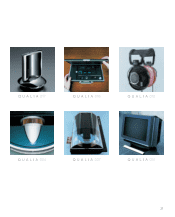Sony 2004 Annual Report Download - page 22
Download and view the complete annual report
Please find page 22 of the 2004 Sony annual report below. You can navigate through the pages in the report by either clicking on the pages listed below, or by using the keyword search tool below to find specific information within the annual report.
20
Memory Stick Duo
Memory Stick PRO Duo
Memory Stick
Memory Stick PRO
CCD with a four-color filter
Image sensors Display components Memory Stick
Tapping the strengths of CCD and CMOS
image sensors
Sony has the leading share of the global mar-
ket for CCDs. This key component not only
supports our lineup of mobile products, such
as digital still cameras and video cameras, but
also contributes to profitability through sales
to external customers. In July 2003, Sony was
the first company to develop a CCD for con-
sumer digital still cameras that has a four-color
filter: red, green, blue and emerald. This break-
through will be leveraged to differentiate Sony
cameras from those of its competitors. We will
also strive to make the CCDs smaller, while
simultaneously enhancing picture quality.
Sony is also developing CMOS image sensors.
This component offers the advantages of low
power consumption, faster processing speed,
and the ability to place peripheral circuitry on a
single chip. Traditionally, picture quality from
CMOS image sensors has been thought to be
inferior to that of CCDs. Sony has almost
completed work on a CMOS image sensor that
produces a higher-quality picture. This is being
accomplished by applying manufacturing know-
how that was gained from the production of
CCDs and using sophisticated equipment for
the MOS process. Sony will continue its CMOS
image sensor development program with the
goal of expanding this business.
Joint venture with Samsung to mass-
produce next generation LCD panels
Demand for flat panel displays is increasing
rapidly, with applications for this technology
ranging from cellular phones, digital still
cameras, televisions, PC monitors and rear-
projection televisions. To ensure a stable
supply of LCD panels to meet the expected
growth in demand for large screen LCD
televisions, Sony and Samsung Electronics Co.,
Ltd. established S-LCD Corporation. This joint
venture will develop and manufacture seventh-
generation (1,870mm x 2,200mm glass sub-
strate) amorphous silicon TFT LCD panels to be
used in large screen televisions. Full scale pro-
duction is scheduled to begin in the fiscal year
ending March 31, 2006.
A rear-projection television with an ultra
high-resolution LCD
As LCD panels with increasingly high-resolution
become available, even small devices will have
the ability to display ultra-fine images. Sony has
developed a display device called the SXRD
(Silicon X-tal Reflective Display) that can pro-
duce high-resolution, high-contrast images with
cinematic quality. Sony will use SXRD to pro-
duce front projectors and rear-projection televi-
sions that will have a far better picture quality
than those currently available.
Practical application for OEL displays
OEL displays can reproduce highly vivid colors
with the fast response required for smooth
video playback. Backlighting is not required
because the panel is self-luminescent, produc-
ing three colors: red, green and blue. This
allows for panels to be extremely slim. Sony is
working toward the practical application of the
OEL display to mobile devices.
Meeting the new demand for increasingly
widespread music distribution and high-
resolution video recording
Since its debut six years ago, the Memory Stick
business has continued to grow rapidly, fueled
by the growth of the digital still camera market.
As a result, cumulative shipments have sur-
passed 70 million units. Sony and more than
500 other companies that support this technol-
ogy are developing new markets for Memory
Stick. Music and e-book distribution services are
two applications that will be added during the
fiscal year ending March 31, 2005, with high-
resolution video recording as another potential
addition. To ensure ease of use for a broad
range of applications, all Memory Stick media is
equipped with copyright protection technology
and high-speed data transfer capability. Sony
plans to launch higher-capacity media with the
introduction of a 2GB version in 2004 and a
4GB version in 2005.
LCD display component, “4K SXRD”
























